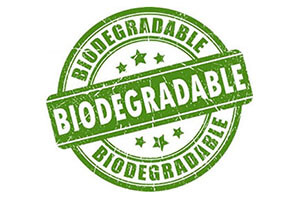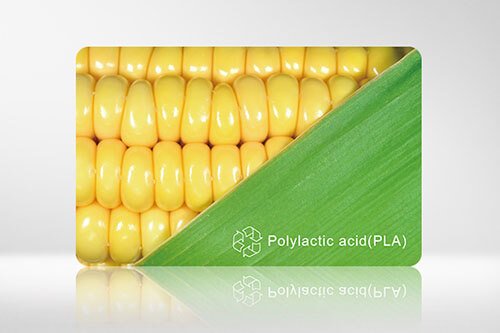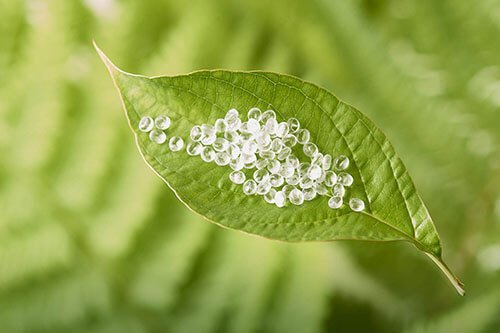Eco-Friendly, Sustainable, Biodegradable Label Material-PLA
2021/01/12

A growing focus on sustainability has businesses looking for environmentally friendly alternatives to traditional materials. One such alternative is transparent biodegradable label made of PLA. PLA is a type of biodegradable materials made from renewable plant resources such as corn. After use it can break down by microorganisms in nature and finally generate carbon dioxide which gets absorbed into the soil or taken up by plants without polluting our environment. With a focus on reducing the environmental impact of business operations, transparent biodegradable labels are an attractive option for many companies.

What is PLA material?
PLA, or Polylactic Acid, is a thermoplastic resin made from corn starch, sugar cane or tapioca roots. It’s classified as a bio-based plastic, meaning it’s derived from renewable resources instead of fossil fuels. PLA is carbon neutral, biodegradable and compostable.
Our biodegradable labels are made of PLA, which has many sustainable benefits. For example, it is internationally recognized and the most popular type of biodegradable plastic. Additionally, PLA is derived from renewable resources and is recyclable.
PLA has a lower carbon footprint than traditional plastics because it is made from renewable resources instead of fossil fuels. Additionally, PLA is biodegradable and compostable, meaning it will break down into harmless substances over time.

PLA Label Material Properties
- The biodegradable eco-friendly labels can actually help to combat climate change! When the product has been buried in soil, its carbon dioxide footprint will be absorbed by plants rather than increasing greenhouse effects.
- The PLA label materials are easy to process by thermoplastic equipment, meaning that the application range of this product can be quite wide.
- Good gloss and transparency.
- The properties of PLA make it perfect for making into a film. It has good air, oxygen and carbon dioxide permeability but also odor isolation qualities!
- Similar printability to other plastic films.
- PLA is a brittle plastic at room temperature, and its impact resistance and heat resistance properties are poor. These shortcomings need to be improved by modification methods, such as adding crystal nucleating agents, inorganic fillers or mixing with other degradable materials. For film applications, the degree of orientation and crystallinity can be changed by stretching to improve impact resistance and heat resistance.
Releated Products: PLA Labels
PLA vs Plastic: What’s The Difference?
PLA and plastic are both man-made materials. PLA is made from natural, renewable resources like cornstarch or sugarcane, while plastic is made from fossil fuels like petroleum. That means PLA is carbon-neutral, while plastic emits greenhouse gases when it’s produced.
PLA is also biodegradable and compostable, while plastic is not. That means PLA will break down into harmless compounds over time, while plastic will just pile up in landfills or in the ocean.
| Biodegradable Material | Generic Label Materials | ||||||
|---|---|---|---|---|---|---|---|
| PLA | PE | PP | PET | PVC | PS | ||
| Processability | Blown Film Forming | 3 | - | 3 | - | 3 | - |
| Extrusion | 3 | 4 | 4 | 4 | 4 | 4 | |
| Biaxial Stretching | 3 | 2 | 4 | 4 | 3 | 4 | |
| Injection Molding | 3 | 4 | 4 | 4 | 4 | 4 | |
| Fiber Forming | 3 | 3 | 3 | 4 | - | 2 | |
| Mechanical Properties | Tensile Strength | 3 | 3 | 3 | 4 | 3 | 3 |
| Impact Strength | 2 | 3 | 4 | 4 | 3 | 2 | |
| Hardness | 3 | 2 | 3 | 3 | 3 | 3 | |
| Softness | 1 | 3 | 2 | 2 | 4 | 2 | |
| Thermal Performance | Softening Temp. | 2 | 2 | 3 | 4 | 3 | 3 |
| Cold Resistance | 3 | 3 | 3 | 3 | 2 | 3 | |
| Optical | Transparency | 4 | 3 | 3 | 3 | 4 | 4 |
| Transmittance | 4 | 2 | 2 | 3 | 3 | 3 | |
| Chemical | Acid And Alkali Resistance | 1 | 4 | 4 | 2 | 4 | 4 |
| Solvent Resistance | 3 | 4 | 4 | 3 | 4 | 2 | |
| Physical | Gas Barrier | 1 | 1 | 1 | 3 | 3 | 1 |
| Hot Water Resistance | 2 | 1 | 3 | 3 | 2 | 2 | |
| Eco Friendly | Biodegradability | 3 | 1 | 1 | 1 | 1 | 1 |
| Additional Performance | Flame Retardancy | 1 | 1 | 1 | 1 | 3 | 1 |
| Conductivity | 1 | 1 | 1 | 1 | 1 | 1 | |
| Label Design | Gloss | 3 | 3 | 3 | 3 | 4 | 4 |
| Coloring | 2 | 4 | 3 | 4 | 4 | 4 | |
| 3 | 2 | 3 | 3 | 3 | 3 | ||
4: Excellent 3:Good 2: Average 1: Poor
What is PLA used for?
PLA is most commonly used in the food industry for items such as biodegradable PLA cutlery, biodegradable drinking straws, biodegradable coffee stirrers, biodegradable toothpicks etc. As it is made from renewable resources, it can be certified as compostable and will break down in commercial composting facilities. PLA is also used in the packaging industry for eco-friendly biodegradable packaging film, biodegradable mailing bags, biodegradable labels and biodegradable shrink wrap.
PLA isn’t just used for food service and packaging though; it has a whole host of other applications. As it is strong and rigid, yet lightweight, PLA is perfect for use in the manufacturing and construction industries. It is also used in the medical industry for biodegradable splints, biodegradable casts and biodegradable sutures.
PLA is used in sustainable packaging materials
PLA eco-friendly label material is a viable sustainable option for product labeling, as they do not produce the waste and pollution commonly associated with traditional plastic labels. Made from cornstarch, PLA biodegradable labels will break down in commercial compost facilities, making them an eco-friendly choice for the environment.

PLA sustainable labels are used for candy packaging, which can be comparable to cellophane and biaxially oriented PP in appearance and performance, with transparency, kink retention, printability and strength. Moreover, high barrier properties can maintain the fragrance of candy.
The temperature resistance of general PLA label materials is not high enough (softening point of 55℃) to limit its application and development, so it is necessary to use a modified method to improve the temperature resistance. Among them, the biaxially stretched PLA film (ie BOPLA) can be greatly improved temperature resistance (up to 100 ℃) and toughness. Compared with BOPET, in addition to the lower temperature resistance than BOPET, its optical properties and heat sealability, BOPLA has better performance than BOPET.
BOPLA Label Material Features
High transmittance, low haze, and very good surface gloss. Therefore, metal plating or processing clear coating products with BOPLA label material will be more radiant and brighter than traditional plastics
BOPLA is a strong polar material, and its adhesion to printing ink and electroplating coating is better than that of corona-treated PET film; and because of its high transparency and minimal haze, the color and layering of the printed image are extremely good.
After biaxial stretching and heat setting treatment, it can basically meet the processing requirements, including the coating processing of water-based coatings.
| BOPLA | BOPET | Testing Method | ||
|---|---|---|---|---|
| Tensile Strength (Mpa) | MD | 135 | 160 | DIN 53455 |
| TD | 150 | 160 | ||
| Elongation At Break (%) | MD | 105 | 100 | DIN 53455 |
| TD | 95 | 90 | ||
| Thermal Shrinkage (%) | MD | 92 | 88 |
100℃ / 1min(BOPLA)
150℃ / 15min(BOPET) |
| TD | 0.5 | 2.0 | ||
| Transmittance (%) | 92 | 88 | ASTM D1003 | |
| Haze (%) | 0.5 | 2.0 | ASTM D1003 | |
| Gloss (Gu) | ≧110 | ≧110 | ASTM D523 | |
| Surface Energy (Dyne/cm) | 38 | 44 | ASTM D1894 | |
Comparison Between PLA and General Plastic Shrink Film?
PLA film has high heat shrinkage, and its dimensional stability is worse than that of PET, which is suitable for heat shrinkable films. PLA heat shrinkable film has the advantages of high strength, large shrinkage force, good transparency and good printability, so it can be used as a label for plastic bottles.
| High Transparent PLA | High Impact PLA | OPS (Stretch PS) | PETG (Modified PET) | PVC | ||
|---|---|---|---|---|---|---|
| Elongation at Break (%) | MD | 3 | 110 | 109 | 418 | 194 |
| TD | 4 | 58 | 60 | 58 | 43 | |
| Thermal Shrinkage (%)(100℃/5min) | MD | 37 | 8 | 6 | 2.5 | 6.5 |
| TD | 70 | 68 | 72 | 62.5 | 56.5 | |
| Haze (%) | 0.6 | 7.2 | 6.0 | 5.0 | - | |

Releated Products: PLA Labels
Category
